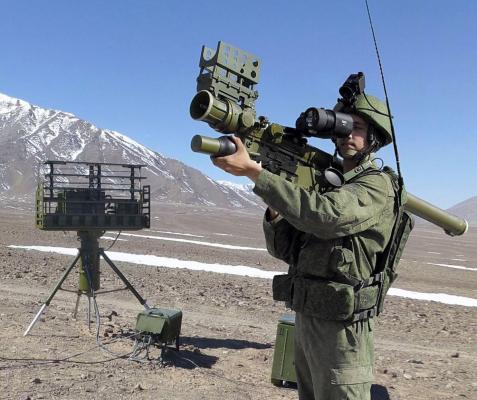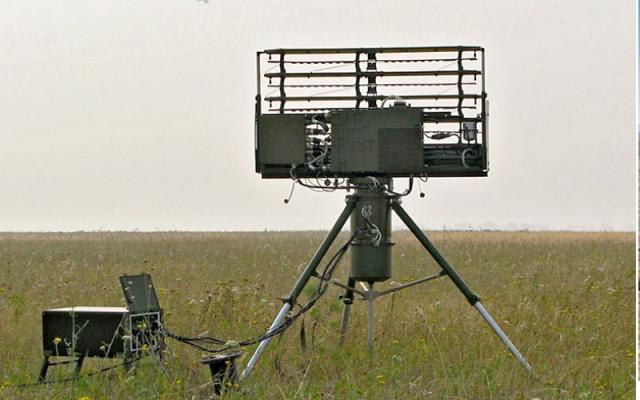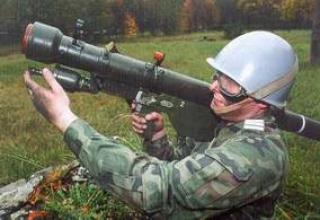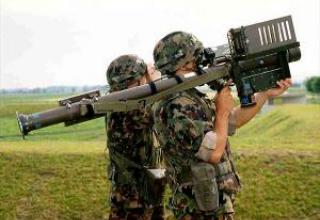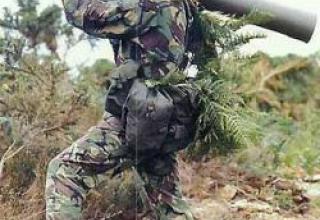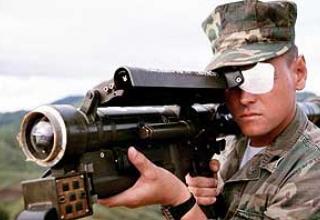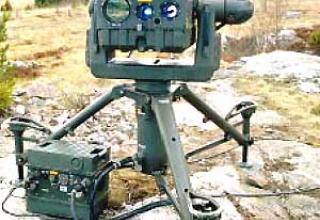Portable anti-aircraft missile system (MANPADS) 9K333 "Verba" is designed to destroy aircraft, helicopters, unmanned aerial vehicles and cruise missiles on counter and overtaking courses in an organized optical interference in the visual visibility of the target and at night.
The leading developer of the complex is JSC NPK Machine Building Design Bureau (Kolomna).
The complex "Verba" passed state trials in 2011, adopted for service in 2015. It was first demonstrated at the International Military and Technical Forum "Army-2015".
Man-portable air defense system "Verba" is a further development of the complex "Igla-S", surpasses it in efficiency by 1.5 ... 2 times, especially at the borders of more than 3 km, has an increased area of firing of standard air targets, a smaller mass of combat vehicles.
Composition:
Composition of complex 9K333 "Verba":
- Militants:
- anti-aircraft missile 9M336 in a tube;
- launch mechanism 9P521;
- ground radio requestor 1L229V (see photo).
- Maintenance facilities:
- mobile control point 9B681;
- test equipment for 9B682 bases and arsenals.
- The training means are represented by a single complex of 9F879 training means in the composition:
- equipment of a computer training room for 9F877 man-portable air defence systems;
- the simulator unified for training of the needle-type man-portable air defence systems shooters, class 9F874;
- multipurpose complex simulator 9F859;
- tactical training field kit 9F663M (see photo);
- 9F635M1 Man-portable air defense systems of "Needle" family (see photo);
- a set of 9K333-MACET dimensional and mass layouts of combat vehicles.
The 9M336 (see photo) is equipped with a new homing head (Homing Head) and a new instrument compartment. The missile's CNS is a passive passive three-spectral tracking system operating in the ultraviolet, near and mid-infrared ranges. Due to the increased sensitivity of the CNS, the area for the capture and engagement of standard air targets has been increased by a factor of 2.5 as compared with the Igla-S man-portable air defence systems. The pyrotechnic interference immunity of the complex has been increased by at least 10 times. The new homing head provides selection of false thermal targets with powerful thermal radiation. One of the main advantages of the Verba man-portable air defence system is a high probability of hitting low-radiation targets like cruise missiles and unmanned aerial vehicles.
The combat unit (BC) of the 9M336 missile is a shrapnel-array with a non-contact fuse. The guidance system retains the missile's displacement scheme when approaching the most vulnerable parts of the aircraft and the principle of detonation of engine fuel remnants.
It can be used in any geographic zones, including mountain and sea conditions, in the temperature range from -50 to +50 °С.
To increase the effectiveness of man-portable air defence systems "Verba" can be equipped with detection, recognition, fire control and target designation.
The following items can be added to the 9K333 man-portable air defence systems "Verba": removable night vision sight 1PN97M "Maugli-2M" (see photo), which allows the complex to be used in night conditions, small-size radar detector 1L122 "Harmony".
Radar 1L122 is designed to detect air targets of different types, their automatic tracking and the issuance of information on the routes to different consumers. Characteristic feature of the station, positively affecting the parameters of its operation, is the use of phased antenna grating size 1200x800mm. Horizontal view is provided by antenna rotation mechanisms, vertical - by electronic scanning.
Depending on the modification, "Harmony" station is able to update data on the targets with a rate of 2 to 10 s, which is determined by the speed of rotation of the antenna array. Receiving a direct current of 22-30 V and consuming up to 800 W, the station provides target search at ranges up to 40 km and altitudes of at least 10 km. It provides all-around visibility of the azimuth and tracking of the sector within the angles from -5° to +45°. The maximum speed of an air target is 700 m/s. Target coordinates are determined with an accuracy of 100m in range, 30' in azimuth and 1°30' in the angle of place. It is possible to work in conditions of application by the enemy of passive and active hindrances of certain power. When used as a mobile system, the 1L122 radar is equipped with a control and monitoring system in the form of a protected laptop computer and communication facilities.
A portable fire control module (PMUO) 9C933 has been developed to equip the control point of the platoon commander of the anti-aircraft gunners' platoon.
The PMUO 9С933 is a part of the Barnaul-T automation kit, designed for automated control of the man-portable air defence systems departments and ensures more efficient weapons management. The module is made in the form of an army satchel, which in a few minutes can be turned into a fully automated workstation commander. The equipment provides data exchange with superior command posts, message with arrows, air targets tracking by information from external radars, target designation, as well as receiving and forming reports on the performance of tasks. PMUO 9C933 provides simultaneous solution of fire tasks for 15 targets. The module allows receiving operational information about the air situation in a given sector of shooting, displays information about the target trajectory on the computer screen, performs automatic target designation and setting of firing tasks to the anti-aircraft gunners, taking into account their location and readiness for the task.
The 9C935 Anti-aircraft gunners division automation system (AACS) from the Barnaul-T AACS is designed to equip the man-portable air defence systems departments, coordinate their activities and improve the effectiveness of weapons management under any combat conditions (see photo). KSAC elements are placed on a wearable vest and helmet in order not to reduce the manoeuvrability of platoons and anti-aircraft gunners' offices.
The 9M336 missile can be used not only as a shoulder-fired version, but also as an interspecies unified air-to-air combat vehicle to equip various ground, air and sea-based carriers.
At the International Military and Technical Forum "Army-2016" were presented a branch fighting vehicle (BMW) and a reconnaissance and control vehicle of the platoon commander (MRUK) from the "Gibka-S" complex. "Gibka-S" is the result of cooperation between companies-smiths headed by JSC "SPC" Heavy Machine Building Design Bureau. The developers include JSC SPE "Rubin" (Penza), JSC "Saratov Aggregate Plant", JSC "State Ryazan Instrument Plant", FSUE "Research Institute of Applied Acoustics" (Dubna), JSC "All-Russian Scientific Research Institute "Signal" (Kovrov), FSUE "GosNIIAS". (Moscow).
MANPADS is an armored mobile vehicle of the anti-aircraft gunners' department with standard arms, ammunition and property. The vehicle is designed to defend the general army units from airborne attack means, flying at low and ultra low altitudes, in all types of combat, day, night and on the march.
The BMA can use both the latest man-portable air defence systems "Verba" and "Igla-S". Ammo has eight missiles in its payload. Four of them are placed on a launcher. BMD operation is automated to the maximum extent possible. Mode of warfare - stand-alone or under the control of command posts from the basic kit of the Barnaul-T AMS.
The reconnaissance and control vehicle of the platoon commander is designed for automated control of the actions of the anti-aircraft gunners' departments. The MRUK includes 1L122 "Harmony" small-size radar. The MRUK allows for prompt interaction with higher command posts and control of six subordinate combat vehicles or four divisions of anti-aircraft gunners equipped with 9C935 automation kits. The guaranteed communication range of the MRUK with the BMA is 17 km during parking and 8 km during driving.
BMO and MRUK are based on the "Tiger" vehicle. The MRUK crew is a commander, a telephonist operator and a driver. BMO crew - driver, MANPADS section commander, two anti-aircraft gunners.
Characteristics:
| Range of impact, m | 500 - 6000 |
| Height of targets, m | 10 - 3500 |
| Defeatable target parameter, m | up to 3 000 |
| Target velocity, m/s - oncomingcoming courses - in a catch-up course |
up to 400 up to 320 |
| Weight of combat vehicles, kg | 17,25 |
| Rocket caliber, mm | 72 |
| Mass BC missiles, kg | 2,5 |
| Time to transfer combat assets from camping to combat, s | not more than 12 |
| Operating temperature range | from -50°C to +50°C |
| The military calculation, man. | 1 |
Thermal sight Maugli-2M
| Corner field in object space, deg | 24 |
| Dioptric adjustment, dpt. | -3…+6 |
| Device resolution limit, angle min | 10 |
| Spectral range, µm | 8-12 |
| Bolometric Matrix Format, Pixel | 320х240 |
| Frame rate, Hz. | 50 |
| Time to transfer combat assets from camping to combat, s | not more than 12 |
| Operating temperature range | from -50°C to +50°C |
| Power supply voltage, V | 12 |
| Operating temperature range, ° C | between -40 and +50 |
| Continuous operating time (without changing the battery), h at least | 8 |
| Overall dimensions, mm | 256х135х109 |
| Weight, kg no more. | 1,5 |
Testing:
05.09.2008 The US Navy conducted the second test of SM-6 surface-to-air missiles with over-the-horizon guidance. The missile intercepted a BQM-74 air target.
01.09.2012 In the course of the test, SM-6 was used to destroy a cruise missile target and receive designation from the JLENS system.
01.03.2013 Raytheon delivered the first SM-6 to the U.S. Navy, assembled at its new assembly and test facility in Huntsville, Alabama.
14.06.2013 The Republic of Korea has decided to begin equipping its Aegis destroyers with SM-6 anti-aircraft missiles from 2016. The decision was adopted within the South Korean government's programme on the creation of a national air and missile defence system (KAMD).
26.08.2013 The U.S. Navy fired two SM-6 anti-aircraft missiles from the USS CG-52 Chancellorsville (Ticonderoga class), which successfully intercepted two BQM-74 air targets that simulated cruise missiles.
18-20.06.2014 The USS DDG-23 John Paul Jones destroyer launched four SM-6 missiles for training purposes. One of these launches was classified as "the furthest aerial target intercept in naval history".
14.08.2014 Successful launch of SM-6 missile against a low-altitude subsonic target flying over land. The missile, launched at the command of the launch vehicle into the intended target area, independently searched and hit the target. It demonstrated the ability of the missile's ARGSN to successfully counteract interference from the underlying surface.
24.10.2014 Successful reflection of simultaneous attack of low-sonic BQM-74E and supersonic GQM-163A targets simulating anti-ship missiles. Both targets were intercepted at low altitude by SM-6 missiles launched from the USS CG-62 Chancellorsville cruiser. The launch vehicle was behind the radio-horizon, intercepted by the USS DDG 102 Sampson destroyer using SM-6 ARGSN capabilities.
28.07.2015 The US Navy successfully tested a modified version of SM-6 Dual I missile capable of intercepting ballistic targets.
18.01.2016 The SM-6 missile, launched from the USS DDG-23 destroyer John Paul Jones, hit a surface target - the decommissioned USS FFG-57 destroyer Reuben James. The test was a demonstration of the U.S. Navy's "distributed power" concept. According to this concept, it is assumed that as part of a networked ship group, some ships detect targets, others accompany them, and others strike them.
07.03.2016 The destroyer USS DDG-23 John Paul Jones successfully intercepted five targets using SM-6 SSDs, updating the maximum range record for an air target, which was set in 2014.
14.09.2016 The SM-6 missile for the first time intercepted a Zagorizon medium-sonic target using a communication channel with an F-35 fighter. The rocket was launched by the USS Desert Ship (LLS 1) launch complex equipped with the AEGIS Baseline system. The task was the last stage in a series of tests of the Naval Integrated Fire Control Counterair Network (NIFC-CA) designed to provide interaction between U.S. Navy ships and various aircraft (such as F-35 fighter aircraft) in a single integrated network. During the tests, the interceptor missile received continuous target designation from the fighter, which ensured the successful interception of the target outside the detection area of the launch complex radar.
14.12.2016 The U.S. Navy, with support from the U.S. Agency for Defense, conducted the first test of the SM-6 Dual I anti-aircraft missile to intercept a target simulating a medium-range ballistic missile. It was launched off the coast of Hawaii from a USS John Paul Jones destroyer (DDG 53) equipped with the Aegis baseline 9.C1 system. Two missiles were fired at the target.
30.08.2017 Two SM-6 Dual I interceptor missiles were launched from the USS John Paul Jones destroyer (DDG 53) against a target that simulated a medium-range ballistic missile. During the test, the target was detected, captured, escorted, and two interceptor missiles were launched. During the test, the Aegis Baseline 9.1 (BMD 5.0CU) Ballistic Missile Defense (BMD) battle control system was used.
Sources:
- Переносный зенитный ракетный комплекс «Верба»
- «Верба» против «Стингера»: новейший российский ПЗРК не имеет аналогов в мире
- В центре внимания — «Верба» и «Гибка-С»
- ОПК представит на Defexpo India переносной модуль управления огнем
- Комплект подсистемы управления ПВО тактического звена «Барнаул-Т»
- http://bastion-karpenko.ru/verba-pzrk-arnia-2015/
- Тепловизионный прицел Маугли-2М
- Десантники демонстрируют «Барнаул-Т»
